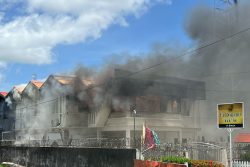While no-one can reasonably gainsay the importance of the sugar industry to the country and its historic impetus in the development of Guyana, it doesn’t mean that citizens and watchdogs must turn a blind eye to what is transpiring and to write a blank cheque for unlimited expenditure.
Of course, any examination of the Guyana Sugar Corporation (GuySuCo) will be coloured by the fact that the industry has been a pivotal constituency of the governing PPP/C and its manifesto for the 2020 general election had encompassed extravagant promises for the reopening of three estates.
By any measure the results have been disastrous and as another election cycle looms better sense has to prevail and the losses have to be reined in. Aside from the legendary community and health centres which provided pivotal services to workers and their families but which now don’t exist in that format, drainage was another of the legacy attributes of GuySuCo that tended to be overlooked. The need to ensure that sugar estates were efficiently drained and irrigated had hugely beneficial effects on surrounding communities. Now, some of these responsibilities have been taken over by the National Drainage and Irrigation Authority.
Newly appointed Chief Executive Officer Paul Cheong was asked by Stabroek News in an interview about GuySuCo’s losses for the period from 2021 to 2023. He provided the 2021 and 2022 figures and said that last year’s books were not yet audited. The corporation recorded back-to-back losses of $7.8 billion and $10.2 billion respectively in 2021 and 2022. The prognosis is no better for 2023 and 2024 has started with the worst first crop in the industry’s history – 6, 737 tonnes of sugar as opposed to the 16,000 tonnes targeted.
Mr Cheong demurred on the question of the cost of production for a pound of sugar which has been the traditional metric for assessing how the industry was doing financially and which figure was what underpinned the US$200m investment in the ill-fated Skeldon Sugar Modernisa-tion Programme under the Jagdeo administration.
Last week, the Chairman of Region Six, David Armogan provided details on another key metric which told its own story about what is happening in the industry. He stated, “So far the TC/TS (tonnes cane/per tonne sugar) at Rose Hall has not been good, in fact it is in the 20s, and in Albion it is 14, so we have to be able to look at Rose Hall to bring down the TC/TS because we are using far more canes at Rose Hall to make a ton of sugar.” It goes without saying that the cost of production of sugar and the TC/TS across all four grinding estates must be provided to the public.
It doesn’t need underlining that with the fifth year of this government underway the PPP/C government has failed to turn sugar around. While the Rose Hall estate has limped to its promised reopening it is clearly not without problems as it relates to the efficiency and cost of sugar production. There are also other problems. Less than a year after reopening, 240 tonnes of sugar cannot be accounted for and this had led to two senior employees being fired. This has triggered industrial unrest.
There was no grinding at the Albion estate this year after a devastating fire hit its power house in February. As in other areas, GuySuCo has had very little to say on this. What had initially been mooted as a huge $50m cost to be fixed has now spiralled astronomically to $600m based on a request to Parliament for supplementary financing. That fire therefore was an enormous disaster requiring a commission of inquiry. The oil revenues coming into this country are not intended to be easy pickings for all the shortcomings in whichever sector. This government is spending profligately without any hint of restraint and the monies are being used to paper over outrages such as the power house fire. Was it human error? Was it the external supply to the facility. Was it something else? The public must have answers.
The workers who were formerly with the East Demerara Estate ((Enmore/LBI) are yet to be re-employed. That estate will not be reopening contrary to the pledge of the PPP/C and the investment that had been earmarked for it has had trouble getting going. In the interim, the functioning Enmore packaging plant built in 2011 at a cost of US$12 million with part-financing from the European Union was uprooted to make way for the stalled investment and is still to be reassembled. So much for judicious decisions.
As for the Skeldon factory, there could never have been a viable plan for it resuming operations. The Skeldon project will remain as one of the largest public sector failures in the Caribbean and a case study on how not to run state corporations. The final story on this severe financial disaster has not been written as the various principals keep adding and subtracting to their stories but it must be told.
There other serious questions that are still to be comprehensively addressed. Is the corporation on the right path as it relates to mechanization or as Tony Vieira and others have suggested it is headed for more problems?
Earlier this year, GuySuCo recruited non-English speaking factory experts from Cuba when the locals say English-speaking field experts could have assisted in improving productivity in the fields so that factories could then function at optimal capacity. What are the terms and conditions of these Cuban managers and why didn’t an industry as old as Havana’s have its own answers?
These are but some of the issues plaguing the sugar industry and which portend further problems down the road. Are we even producing enough sugar to export reliably to a premium or at least profitable market?
The government must seriously contemplate these issues without the arrogance of incumbency or political blindspots.









